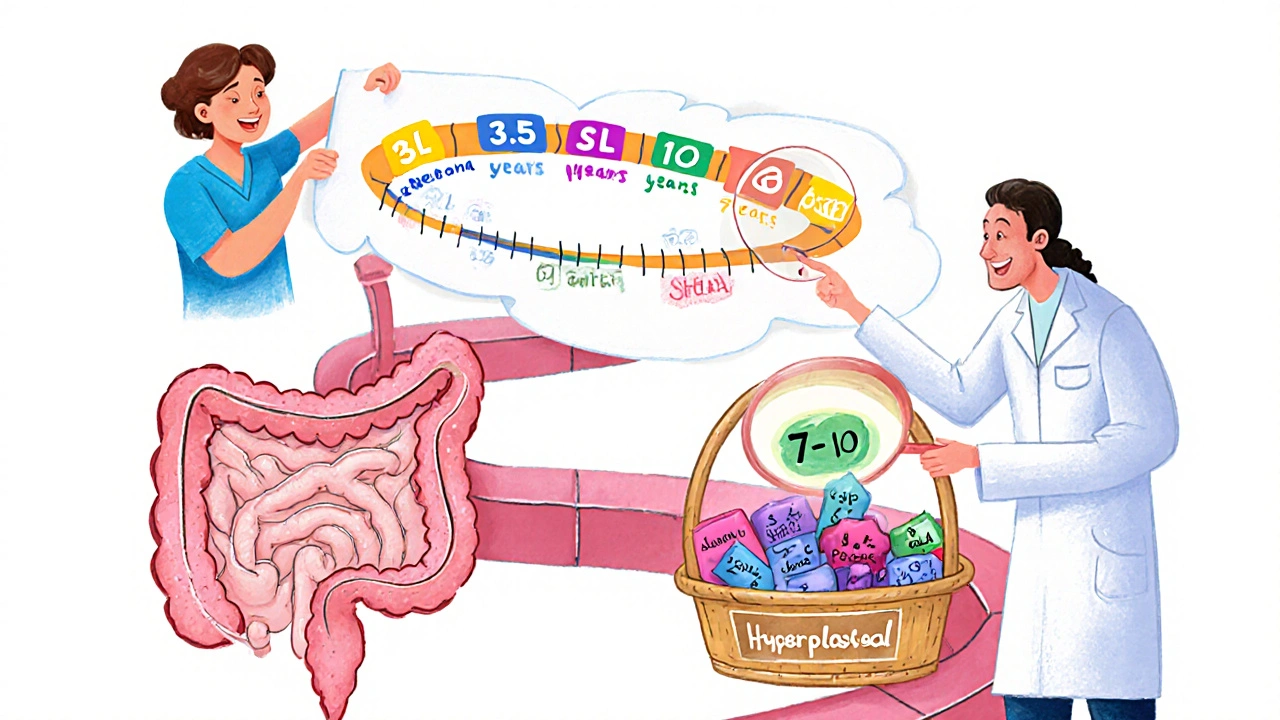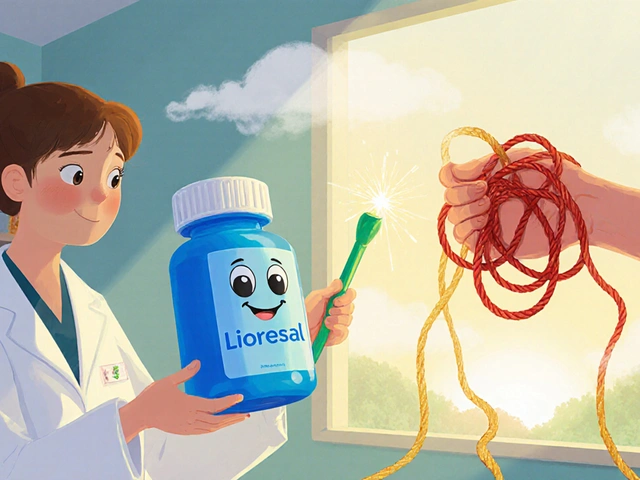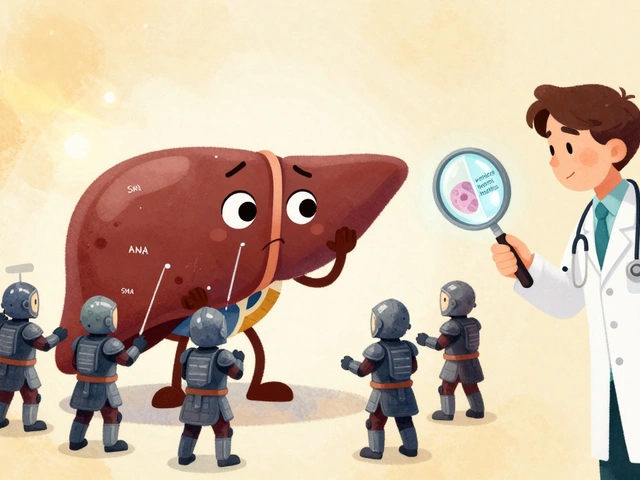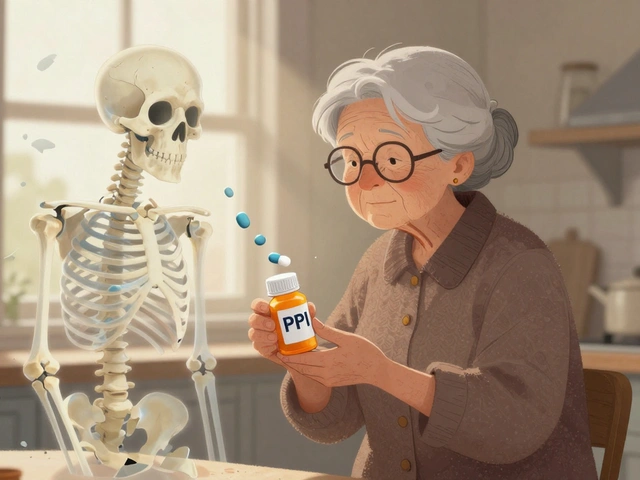
When Do You Need Another Colonoscopy After Polyps Are Removed?
You just had a colonoscopy. The doctor found polyps, removed them, and told you to come back in a few years. But how many? Three? Five? Seven? Ten? You leave the office confused, scrolling through your phone later, wondering if you heard right. You’re not alone. Even many doctors struggle with the exact timing. The truth is, colonoscopy intervals after polyp removal aren’t one-size-fits-all. They depend on the type, size, number, and even the shape of the polyps you had.
Back in the day, if you had any polyp, you got a 3- to 5-year follow-up. But that changed. New research showed most small polyps grow so slowly that waiting longer is not only safe-it’s smarter. The goal isn’t to rush back every few years. It’s to catch the dangerous ones before they turn into cancer, without overdoing it. Too many repeat colonoscopies mean unnecessary risk, cost, and stress. Too few, and you might miss something serious.
What Kind of Polyps Matter Most?
Not all polyps are created equal. There are three main types that drive the timing of your next colonoscopy: adenomas, serrated polyps, and hyperplastic polyps.
Adenomas are the most common and the ones most likely to become cancerous over time. They’re classified by size and how abnormal the cells look under the microscope (histology). A small adenoma under 10 mm is less risky than one over 10 mm. If it has villous features or high-grade dysplasia, that’s a red flag. These are called high-risk adenomas and need closer follow-up.
Serrated polyps are trickier. They don’t always look dangerous under the scope, but some-especially sessile serrated lesions (SSLs)-can turn into cancer quickly if missed. SSLs under 10 mm are usually low-risk if there are only one or two. But if you have five or more, even if they’re small, your risk jumps. That’s why doctors now pay close attention to how many you have, not just how big.
Hyperplastic polyps are usually harmless-unless they’re larger than 10 mm or located in the right side of the colon. If you have a big hyperplastic polyp, it’s hard to tell if it’s really just a benign bump or a hidden serrated lesion. In those cases, doctors err on the side of caution and treat it like a higher-risk polyp.
Your Personal Surveillance Timeline
Here’s what your follow-up schedule should look like based on what was found during your procedure, according to the latest 2020 U.S. guidelines:
- 1-2 small adenomas (≤10 mm): Wait 7 to 10 years. This is the biggest change from older guidelines. If your polyps were tiny and low-risk, you’re almost as safe as someone with a normal colonoscopy.
- 3-4 adenomas (all under 10 mm): Come back in 3 to 5 years. The risk increases slightly with more polyps, even if they’re small.
- 5 or more adenomas: Return in 3 years. This is a clear signal your colon is more prone to developing growths.
- Any adenoma ≥10 mm: Follow up in 3 years. Size matters. Larger polyps take longer to remove completely and have a higher chance of returning or hiding nearby.
- Adenoma with high-grade dysplasia or villous features: Also 3 years. These features mean the cells are changing faster.
- 1-2 sessile serrated lesions (SSLs) under 10 mm: Wait 5 to 10 years. Same as small adenomas. But if you have 3-4, drop to 3-5 years. Five or more? Back in 3 years.
- Hyperplastic polyp ≥10 mm: Come back in 3-5 years. Especially if the bowel prep wasn’t perfect or the polyp was hard to see.
- Piecemeal removal of a polyp ≥20 mm: You need a repeat colonoscopy in 6 months. This is because pieces left behind can regrow. Waiting longer increases risk.
These numbers come from the U.S. Multi-Society Task Force on Colorectal Cancer, which updated its guidelines in 2020. But they’re not the only ones. In Europe, some guidelines allow up to 12 years for very low-risk cases. In the U.S., most doctors follow the 7-10 year rule for small adenomas-but many still default to 5 years out of habit or fear of missing something.

Why Do So Many People Get Colonoscopies Too Soon?
Here’s the hard truth: most people who get colonoscopies after polyp removal are being called back too early.
A 2020 study at a Veterans Affairs hospital found that only 18.6% of doctors followed the updated 7-10 year recommendation for small adenomas. Nearly 8 out of 10 still said, “Come back in 5 years.” Why? Fear. Legal concerns. Lack of training. Patients asking, “Shouldn’t I be checked sooner?”
Even worse, many doctors don’t know how to classify serrated polyps. One survey found only 28.5% of gastroenterologists could correctly identify the right interval for small SSLs. That’s a huge gap. And it’s not just doctors-primary care providers often give out wrong advice because they don’t have the full picture.
As a result, millions of unnecessary colonoscopies are done every year in the U.S. That costs billions. It exposes people to risks like bleeding or perforation. And it clogs up the system, making it harder for people who truly need one to get timely care.
What If Your Bowel Prep Wasn’t Perfect?
Colonoscopy isn’t magic. If your colon wasn’t fully cleaned out, the doctor might have missed something. That’s why the guidelines say: if the prep was poor, you need a repeat colonoscopy sooner-usually in 1 year.
Same goes if the polyp wasn’t fully removed. If it was taken out in pieces (piecemeal resection), especially if it was over 20 mm, you need a follow-up in 6 months to make sure nothing’s left behind.
And if you have a condition called serrated polyposis syndrome-where you have dozens of serrated polyps-you’ll need annual checks until age 75. This is rare, but if you’ve been diagnosed, stick to the schedule. Skipping one could be dangerous.
Tools That Help You and Your Doctor Get It Right
Technology is starting to help. Apps like Polyp.app, developed by experts at Massachusetts General Hospital, let doctors plug in your polyp details and instantly get the right interval. Many hospitals now have these tools built into their electronic health records. When your doctor documents the size, number, and type of polyps, the system pops up a recommendation: “Next colonoscopy: 7 years.”
Still, it’s not foolproof. You need to make sure your doctor is using it-and that they’re entering the right data. If they write “adenoma” without noting the size or histology, the system can’t help.
That’s why it’s smart to ask for a written summary after your procedure. Ask for: the number of polyps, their sizes, what type they were, and the recommended next colonoscopy date. Keep that paper. Bring it to your next appointment. Don’t rely on memory.

What’s Coming Next?
The future of colonoscopy surveillance isn’t just about counting polyps. Researchers are working on blood and stool tests that can detect molecular markers linked to cancer risk. Think of it like a genetic fingerprint for your colon. In the next few years, you might get a test that says: “Your risk is low-wait 10 years,” or “Your risk is high-come back in 2.”
Right now, trials are testing DNA methylation patterns and other biomarkers to personalize timing. This could mean fewer colonoscopies for low-risk people and more focused checks for those who really need them.
But until those tools are widely available, the best advice remains simple: know what was found. Know the guidelines. Ask questions. Don’t assume the next colonoscopy is always 5 years away.
What to Do After Your Colonoscopy
After your procedure, here’s what you should do:
- Get a written report that lists the number, size, and type of polyps removed.
- Ask your doctor: “Based on what was found, when should I come back?”
- Write down the exact recommendation-not “in a few years,” but “in 7 years” or “in 3 years.”
- Set a reminder in your phone or calendar for that date.
- Don’t wait for your doctor’s office to call you. Take charge. Most practices don’t have systems to track this well.
And if you’re ever unsure, ask for a referral to a gastroenterologist who specializes in colorectal cancer prevention. They’re trained to interpret these guidelines accurately.
How soon do I need another colonoscopy if I had one small adenoma?
If you had one small adenoma (under 10 mm) with no high-risk features like villous histology or high-grade dysplasia, you should wait 7 to 10 years before your next colonoscopy. This is based on the 2020 U.S. guidelines, which show that the risk of developing colorectal cancer in this group is nearly the same as someone with a completely normal colon.
Why did my doctor say 5 years when I read online it’s 7-10 years?
Many doctors still follow older guidelines or feel more comfortable recommending a 5-year interval out of caution. Even though the 2020 guidelines extended the interval for low-risk polyps, studies show only about 1 in 5 U.S. gastroenterologists consistently follow the updated recommendation. It’s not that they’re wrong-they’re often just cautious or unaware of the latest data. Ask for the reasoning behind their recommendation.
What if I have hyperplastic polyps instead of adenomas?
Most hyperplastic polyps are harmless, especially if they’re small and in the lower colon. But if you have one that’s 10 mm or larger-or if it’s in the right side of the colon-your doctor may treat it like a higher-risk lesion. In those cases, a 3- to 5-year interval is recommended, especially if the bowel prep was poor or the polyp was hard to remove completely.
Do serrated polyps need more frequent follow-up than adenomas?
It depends. Small sessile serrated lesions (SSLs) under 10 mm with only one or two found follow the same 5-10 year interval as small adenomas. But if you have three or more, or if they’re larger than 10 mm, the interval drops to 3-5 years. Five or more? Back in 3 years. SSLs are sneaky-they can turn into cancer faster than adenomas if missed, so quantity matters as much as size.
Is it safe to wait 10 years if I had 1-2 small polyps?
Yes. Multiple large studies have shown that people with 1-2 small adenomas have a 98.7% to 99.3% chance of being cancer-free at 10 years-nearly identical to people with no polyps at all. Waiting 10 years reduces unnecessary procedures, lowers costs, and avoids risks like colon perforation. The key is making sure the initial colonoscopy was thorough and the polyps were fully removed.
What if I had a polyp removed in pieces?
If a polyp over 20 mm was removed in pieces (piecemeal resection), you need a follow-up colonoscopy in 6 months. This is because leftover tissue can regrow or hide cancer. Waiting longer increases the risk of missing a recurrence. The 6-month check ensures the area is clear before extending the interval again.
Final Thoughts
Colonoscopy isn’t a one-and-done deal after polyps. But it’s also not a lifetime of yearly visits. The system has gotten smarter. The science is clear. You don’t need to rush back unless your polyps were large, numerous, or had dangerous features. The goal isn’t to panic every time a polyp is found. It’s to stay calm, get the facts, and follow the right timeline.
Take control. Ask for your report. Know your numbers. Don’t let outdated advice or fear drive your schedule. The next colonoscopy might be 10 years away-and that’s a good thing.







Erika Sta. Maria
November 21, 2025 AT 18:56Nikhil Purohit
November 22, 2025 AT 18:22Debanjan Banerjee
November 23, 2025 AT 00:13Michael Marrale
November 23, 2025 AT 06:36David vaughan
November 25, 2025 AT 05:44Kartik Singhal
November 25, 2025 AT 12:26Mark Kahn
November 26, 2025 AT 09:45Swati Jain
November 27, 2025 AT 16:34Florian Moser
November 29, 2025 AT 07:16